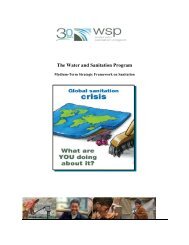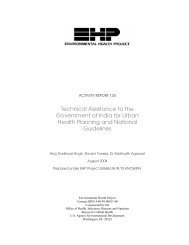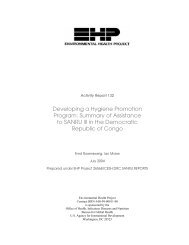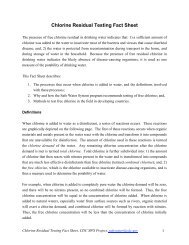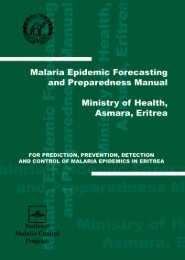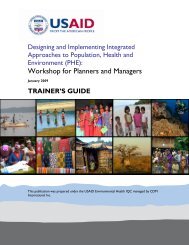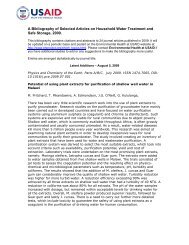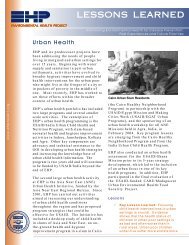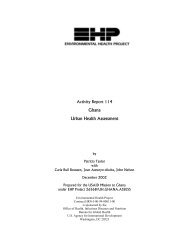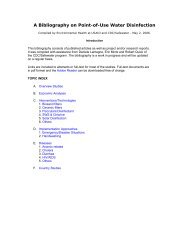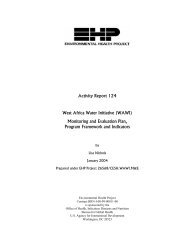Potential for Cross-Sectoral, Multiple-Benefit ProgramsIn the spirit of <strong>Asia</strong>’s Future dialogue, USAID wanted to:Address priority issues rel<strong>at</strong>ed to glacier melt <strong>and</strong> retre<strong>at</strong> <strong>in</strong> a cross-sectoral waydesigned to yield co-benefits <strong>in</strong> multiple sectors.Complement or fill gaps, consider<strong>in</strong>g activities already underway.Correspond with USAID’s <strong>in</strong>terests <strong>and</strong> m<strong>and</strong><strong>at</strong>e.Although the speed <strong>and</strong> degree of glacier melt is uncerta<strong>in</strong>, USAID recognizes the importance ofaddress<strong>in</strong>g vulnerabilities, because even small changes <strong>in</strong> glacier melt will result <strong>in</strong> large impactsdownstream from High <strong>Asia</strong>. With this <strong>in</strong> m<strong>in</strong>d, program concepts <strong>and</strong> approaches have beendeveloped th<strong>at</strong> would address near-term vulnerabilities directly rel<strong>at</strong>ed to glacier melt <strong>and</strong>longer-term vulnerabilities to help build resilience <strong>in</strong> the face of future impacts. Each programapproach has a specific focus, but each is designed to be cross-sectoral <strong>and</strong> to yield co-benefitsacross a range of issues. For <strong>in</strong>stance, a focus on management of w<strong>at</strong>er resources should<strong>in</strong>tegr<strong>at</strong>e governance, food security <strong>and</strong> nutrition, gender equality, regional cooper<strong>at</strong>ion,ecosystem resilience (e.g., susta<strong>in</strong>able forestry), educ<strong>at</strong>ion, <strong>and</strong> the potential to use local groupsto promote good health practices <strong>and</strong> family plann<strong>in</strong>g. Because conditions <strong>and</strong> opportunities willdiffer widely from place to place, Missions can use these descriptions of program approaches asmenu from which to choose, r<strong>at</strong>her than as a cookbook of recipes to follow.The first program concept, “Respond<strong>in</strong>g to the Challenge of a Lack of Inform<strong>at</strong>ion,” addressesthe need for collabor<strong>at</strong>ive <strong>and</strong> <strong>in</strong>tegr<strong>at</strong>ed scientific efforts to <strong>in</strong>crease scientific knowledge <strong>and</strong>to engage <strong>in</strong> monitor<strong>in</strong>g changes <strong>in</strong> glaciers. The two program approaches focus on (1)improv<strong>in</strong>g regional scientific cooper<strong>at</strong>ion of glacier, snowpack <strong>and</strong> w<strong>at</strong>er resources <strong>in</strong> High <strong>Asia</strong>;<strong>and</strong> (2) strengthen<strong>in</strong>g monitor<strong>in</strong>g capacity for clim<strong>at</strong>e <strong>and</strong> w<strong>at</strong>er resources <strong>in</strong> High <strong>Asia</strong>.The second program concept, “Respond<strong>in</strong>g to Vulnerabilities,” addresses both near-termpreparedness <strong>and</strong> longer-term resilience-build<strong>in</strong>g to exist<strong>in</strong>g vulnerabilities, <strong>in</strong>clud<strong>in</strong>g GLOFs <strong>and</strong>the disappearance of some glaciers; w<strong>at</strong>er stress <strong>and</strong> associ<strong>at</strong>ed food <strong>and</strong> nutritional deficits;health issues, particularly popul<strong>at</strong>ion pressures <strong>and</strong> diarrheal diseases associ<strong>at</strong>ed with poorw<strong>at</strong>er quality, as well as malnutrition; thre<strong>at</strong>s to ecosystems, particularly biodiversity; <strong>and</strong>potential governance <strong>and</strong> conflict implic<strong>at</strong>ions of unstable w<strong>at</strong>er supply. The three programapproaches focus on (1) improv<strong>in</strong>g the management of w<strong>at</strong>er resources, (2) conserv<strong>in</strong>gecosystems, <strong>and</strong> (3) prepar<strong>in</strong>g high-mounta<strong>in</strong> communities for direct impacts of glacier melt.The third program concept, “Respond<strong>in</strong>g by Mitig<strong>at</strong>ion,” addresses two different issuessimultaneously, thus present<strong>in</strong>g comb<strong>in</strong>ed opportunities for program <strong>in</strong>tegr<strong>at</strong>ion <strong>and</strong> co-benefits.Black carbon <strong>and</strong> other aerosols likely change the regional clim<strong>at</strong>e <strong>and</strong> acceler<strong>at</strong>e glacier meltwhen black carbon is deposited on reflective glacier surfaces. Therefore, reduc<strong>in</strong>g theseemissions mitig<strong>at</strong>es clim<strong>at</strong>e change <strong>and</strong> thus reduces vulnerability to glacier melt. In addition,reduc<strong>in</strong>g these emissions br<strong>in</strong>gs significant health improvements, particularly to women <strong>and</strong>children <strong>in</strong> households where cook<strong>in</strong>g <strong>and</strong> he<strong>at</strong><strong>in</strong>g are fueled by biomass, <strong>and</strong> to urban dwellerswhere multiple sources contribute to high levels of air pollution. The program approach thusfocuses on reduc<strong>in</strong>g emissions of black carbon <strong>and</strong> other aerosols.4
ConclusionsThe review of scientific <strong>in</strong>form<strong>at</strong>ion about glacier melt <strong>in</strong> High <strong>Asia</strong> revealed, first <strong>and</strong> foremost,a lack of d<strong>at</strong>a <strong>and</strong> <strong>in</strong>form<strong>at</strong>ion, a lack th<strong>at</strong> hampers <strong>at</strong>tempts to project likely impacts <strong>and</strong> takeaction to adapt to changed conditions. Known near-term impacts <strong>in</strong>clude the <strong>in</strong>creas<strong>in</strong>gpotential for GLOFs <strong>and</strong> the disappearance of small glaciers, especially <strong>at</strong> lower l<strong>at</strong>itudes.Underst<strong>and</strong><strong>in</strong>g th<strong>at</strong> glacier melt/retre<strong>at</strong>, although occurr<strong>in</strong>g <strong>at</strong> <strong>in</strong>creas<strong>in</strong>g r<strong>at</strong>es, is not likely toproduce widespread disastrous impacts <strong>in</strong> the next decade or two means th<strong>at</strong> societies havetime to build their resilience to changes <strong>in</strong> the amount of w<strong>at</strong>er available <strong>and</strong> when it arrivesdur<strong>in</strong>g the year. However, exist<strong>in</strong>g vulnerabilities <strong>in</strong> human health st<strong>at</strong>us, popul<strong>at</strong>ion pressure,degraded ecosystems <strong>and</strong> – especially – w<strong>at</strong>er stress make societies <strong>and</strong> ecosystems vulnerableto any changes <strong>in</strong> w<strong>at</strong>er availability as glacier melt acceler<strong>at</strong>es <strong>in</strong> the com<strong>in</strong>g decades.As a result of this analysis, the program concepts developed <strong>in</strong> consult<strong>at</strong>ion with USAIDaddressed three different elements: the challenge of lack of <strong>in</strong>form<strong>at</strong>ion, vulnerabilities rel<strong>at</strong>ed tocurrent societal <strong>and</strong> ecosystem conditions, <strong>and</strong> the need for mitig<strong>at</strong>ion, focus<strong>in</strong>g on blackcarbon. These program concepts represent “no regrets” activities, mean<strong>in</strong>g th<strong>at</strong> they addresscritical needs no m<strong>at</strong>ter how the glaciers respond to clim<strong>at</strong>e change.The multi-faceted analysis presented here leads to the follow<strong>in</strong>g conclusions (listed <strong>in</strong> italics)about the characteristics of programs th<strong>at</strong> are likely to be effective <strong>in</strong> address<strong>in</strong>g glacier melt <strong>and</strong>its impacts:As glacier melt is part of complex, region-wide hydrologic changes th<strong>at</strong> are happen<strong>in</strong>g as a result ofclim<strong>at</strong>e change, effective programs to address glacier melt will be cross-sectoral <strong>and</strong> will achieve cobenefitsacross sectors.Below are examples of benefits th<strong>at</strong> can be part of co-benefit streams:1. Improved health outcomes (from healthier ecosystems, reduced pollution, improvedsanit<strong>at</strong>ion, more efficient w<strong>at</strong>er use);2. Reduced fertility <strong>and</strong> eas<strong>in</strong>g of popul<strong>at</strong>ion pressures (by meet<strong>in</strong>g family plann<strong>in</strong>g needs);3. Strengthened governance <strong>in</strong>stitutions (through environmental, agricultural, <strong>and</strong> forestrymanagement; development of n<strong>at</strong>ional <strong>and</strong> local policies; establishment <strong>and</strong>empowerment of local resource user groups);4. Improved regional cooper<strong>at</strong>ion (through scientific cooper<strong>at</strong>ion, shared monitor<strong>in</strong>g <strong>and</strong><strong>in</strong>form<strong>at</strong>ion programs, common educ<strong>at</strong>ional outreach programs, community-basedmonitor<strong>in</strong>g, strengthened cross-boundary <strong>in</strong>stitutions <strong>and</strong> tre<strong>at</strong>ies);5. Protection of biodiversity <strong>and</strong> ma<strong>in</strong>tenance of ecosystem services (through improvedw<strong>at</strong>er management <strong>and</strong> ecosystem management for health);6. Better w<strong>at</strong>er management <strong>at</strong> all levels, from transboundary/multi-country all the way touse on farm fields <strong>and</strong> for household dr<strong>in</strong>k<strong>in</strong>g w<strong>at</strong>er;5



